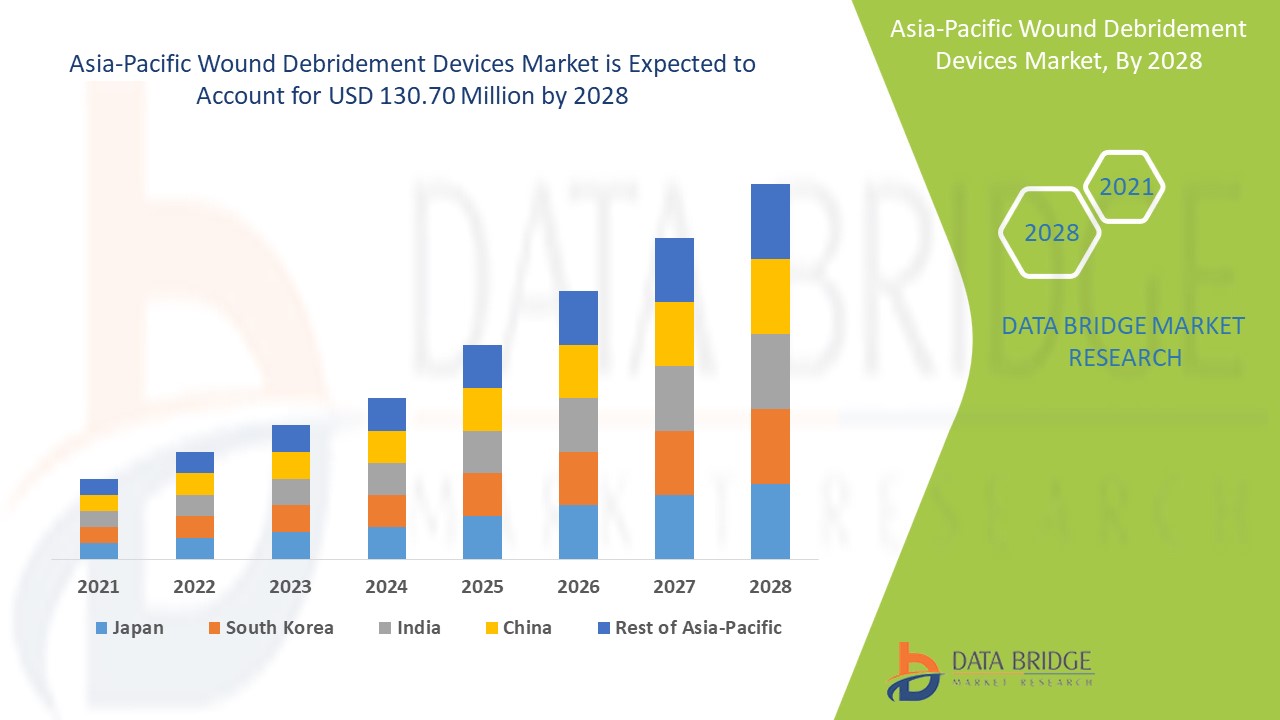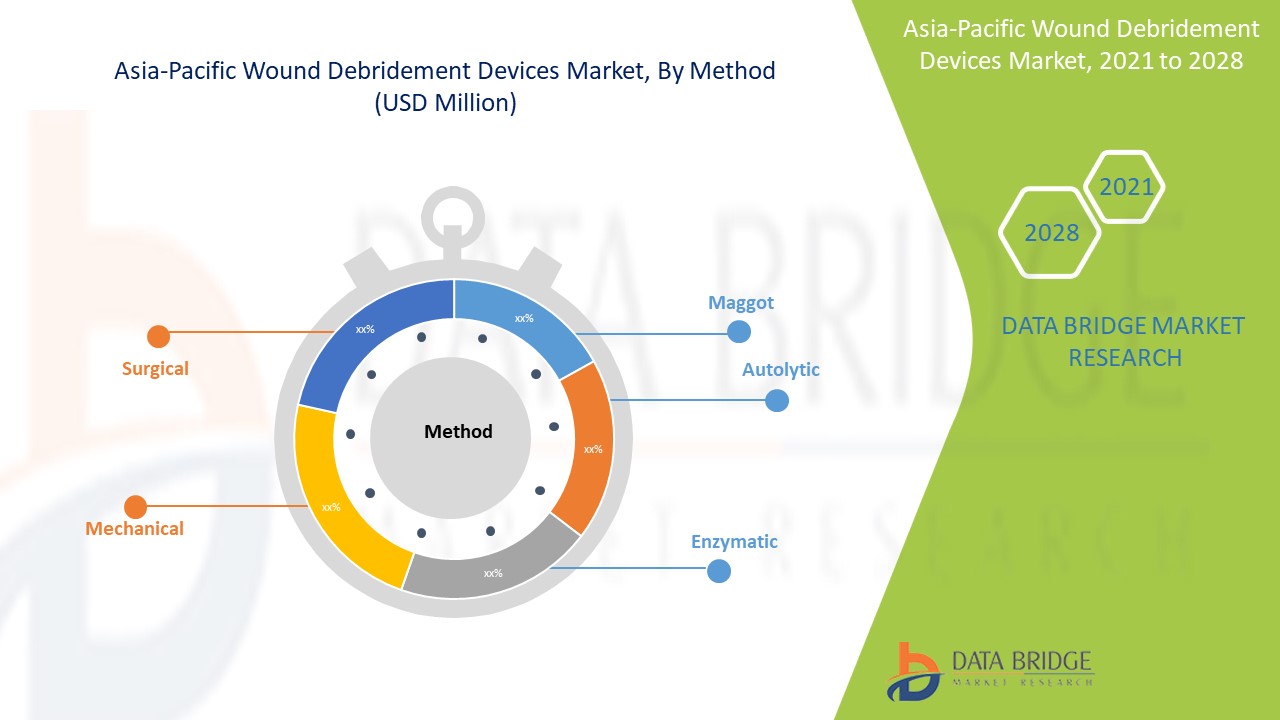Asia Pacific Wound Debridement Devices Market, By Product (Hydrosurgical, Low-Frequency Ultrasound, Mechanical, Larval Therapy, Others), Method (Autolytic, Surgical, Enzymatic, Mechanical, Maggot), Wound Type (Surgical Wounds, Diabetic Ulcers, Burns, Pressure Ulcers, Venous Ulcers, Others), End User (Hospitals, Wound Care Centre, Ambulatory Centre, Home Healthcare, Clinics, Community Healthcare), Country Asia-Pacific (Japan, China, Australia, South Korea, India, Singapore, Thailand, Indonesia, Malaysia, Philippines, & Rest of Asia-Pacific) Industry Trends and Forecast to 2028

Market Analysis and Insights: Asia-Pacific Wound Debridement Devices Market

Asia Pacific wound debridement devices market is expected to gain market growth in the forecast period of 2021 to 2028. Data Bridge Market Research analyses that the market is growing with a CAGR of 5.50% in the forecast period of 2021 to 2028 and is expected to reach USD 130.70 million by 2028 from USD 86.52 million in 2020. The rising incidence of diabetes and growth of novel technological advancements for wound debridement devices are likely to be the major drivers which propel the demand of the market in the forecast period.
The removal of dead and necrotic tissues to accelerate the wound healing process is achieved through debridement devices. The debridement devices include ultrasound based devices, larval therapy and mechanical pad devices. Wound debridement procedure can be achieved through various ways such as autolytic method, enzymatic method, surgical and others. The requirement of wound debridement devices is increasing because these devices remove dead and necrotic tissues and improve the blood circulation of the affected area decreasing the chances of germ infection.
Autolytic methods are generally used for the debridement procedure because it uses body’s own healing process to remove the dead and necrotic cells.
The presence of large number of market players, who are involved in offering the wound debridement devices products and services pave the way for the growth of wound debridement devices market. Moreover, the growth potential in the emerging economies for wound debridement devices bolsters the wound debridement devices market growth. The increased cost of wound debridement products, inconsistencies in the material used and regulatory laws imposed are the restraints which can hinder the market growth.
The Asia-Pacific wound debridement devices market report provides details of market share, new developments, and impact of domestic and localised market players, analyses opportunities in terms of emerging revenue pockets, changes in market regulations, product approvals, strategic decisions, product launches, geographic expansions, and technological innovations in the market. To understand the analysis and the market scenario contact us for an Analyst Brief, our team will help you create a revenue impact solution to achieve your desired goal.

Asia-Pacific Wound Debridement Devices Market Scope and Market Size

Asia-Pacific wound debridement devices market is segmented on the basis of product, method, wound type and end user. The growth among segments helps you analyse niche pockets of growth and strategies to approach the market and determine your core application areas and the difference in your target markets.
- On the basis of product, the Asia-Pacific wound debridement devices market is segmented into hydrosurgical, low-frequency ultrasound, mechanical, larval therapy and others. In 2021, hydrosurgical segment is expected to dominate the wound debridement devices market due to growing cases of diabetic and pressure ulcers, increase in geriatric population and upcoming wound diagnostic centres.
- On the basis of method, the Asia-Pacific wound debridement devices market is segmented into autolytic, enzymatic, surgical, mechanical and maggot. In 2021, autolytic segment is expected to dominate the wound debridement devices market owing to the increasing cases of chronic wounds and preferred method by the patients.
- On the basis of wound type, the Asia-Pacific wound debridement devices market is segmented into surgical wounds, diabetic ulcers, burns, pressure ulcers, venous ulcers and others. In 2021, surgical wounds segment is expected to dominate the wound debridement devices market due to rise of accidents and growth in number of surgeries.
- On the basis of end user, the Asia-Pacific wound debridement devices market is segmented into hospitals, wound care centers, ambulatory centers, home healthcare, clinics and community healthcare. In 2021, hospitals segment is expected to dominate the wound debridement devices market due to the rising number of hospitals across the globe and availability of wound debridement devices in the hospitals.
Asia-Pacific Wound Debridement Devices Market Country Level Analysis
Asia-Pacific wound debridement devices market is analysed and market size information is provided by products, wound type, method, and end user.
The countries covered in the wound debridement devices market report are the Japan, China, India, South Korea, Australia, Singapore, Indonesia, Philippines, and rest of Asia-Pacific.
Asia-Pacific is expected to grow with the highest CAGR in the forecasted periods as in the Asia-Pacific’s Countries demand for wound debridement devices product is increasing very rapidly with the urbanization and laboratory automation. China is expected to dominate in the market in the Asia-Pacific market. China is one of the leading countries to inculcate wound debridement devices market.
The country section of the report also provides individual market impacting factors and changes in regulation in the market domestically that impacts the current and future trends of the market. Data points such as new sales, replacement sales, country demographics, regulatory acts and import-export tariffs are some of the major pointers used to forecast the market scenario for individual countries. Also, presence and availability of Asia Pacific brands and their challenges faced due to large or scarce competition from local and domestic brands, impact of sales channels are considered while providing forecast analysis of the country data.
The Growth Potential for Wound Debridement Devices in Emerging Economies and the Strategic Initiatives by Market Players are creating new Opportunities in the Asia-Pacific Wound Debridement Devices Market
Asia-Pacific Wound Debridement Devices Market also provides you with detailed market analysis for every country growth in particular industry with wound debridement devices sales, impact of advancement in the wound debridement devices and changes in regulatory scenarios with their support for the wound debridement devices market. The data is available for historic period 2011 to 2019.
Competitive Landscape and Asia Pacific Wound Debridement Devices Market Share Analysis
Asia-Pacific wound debridement devices market competitive landscape provides details by competitor. Details included are company overview, company financials, revenue generated, market potential, investment in research and development, new market initiatives, production sites and facilities, company strengths and weaknesses, product launch, product trials pipelines, product approvals, patents, product width and breath, application dominance, technology lifeline curve. The above data points provided are only related to the company’s focus related to wound debridement devices market.
The major companies providing the Asia-Pacific wound debridement devices are Smith+Nephew, Integra LifeSciences Corporation, Zimmer Biomet, Mölnlycke Health Care AB, Medtronic, B. Braun Melsungen AG, Coloplast Group, Hollister Incorporated, Olympus Corporation, Advanced Medical Solutions Group plc, BSN Medical, Lohmann and Rauscher GmbH, Misonix, Söring GmbH among others.
DBMR analysts understand competitive strengths and provide competitive analysis for each competitor separately.
The strategic initiatives by market players along with new technological advancements for wound debridement devices are bridging the gap for chronic wounds treatment.
For instance,
- In January 2017, Integra Life Sciences Corporation acquired the DERMA SCIENCES. Through this acquisition, Integra Life Sciences accelerated the advanced wound care strategy by adding amniotic tissue-based products of Derma Sciences in their product portfolio
Collaboration, joint ventures and other strategies by the market player is enhancing the company market in the wound debridement devices market which also provides the benefit for organisation to improve their offering for wound debridement devices market.
SKU-

